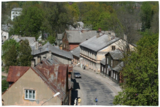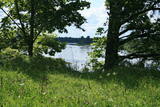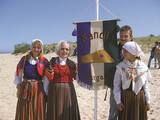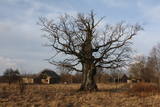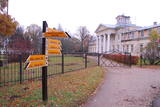| Nr | Nosaukums | Apraksts |
|---|---|---|
|
Lietuvas otra lielākā pilsēta un no 1920. – 1939. g. – pagaidu galvaspilsēta. Vecpilsēta, Rātsnams (16. gs.), Sv. Pētera un Pāvila katedrāle – bazilika (15. gs.), Pērkona māja (15. gs.), Laisves aleja, Čurļoņa (Čiurlionis) mākslas un Velna muzejs. |
||
|
Aizputes pilsdrupas, akmens tilts pār Tebru, Jaunā pilsmuiža, ūdensdzirnavas un Sv. Jāņa luterāņu baznīca, kā arī 19. gs. beigās celtās koka ēkas starp Jāņa, Katoļu un Atmodas ielu veido neparastu pilsētbūvniecības kompleksu, kam piešķirts kultūras pieminekļa statuss. Staigājot pa vēsturisko centru, uzmanība jāpievērš ēku durvīm un to vērtnēm, logu ailēm, balkonu margām u.c. elementiem. |
||
|
No vēsturiskā un arhitektoniskā viedokļa – interesants 17. - 19. gs. pilsētbūvniecības piemineklis. Vecliepāja atrodas Vecā tirgus un Kuršu laukuma rajonā, kur no 16. gs. 60. gadiem notikusi tirdzniecība. Līdz 1792. g. Kuršu laukums bija arī soda izpildes vieta. 1910. g. tam līdzās izveidoja tagadējo Pētertirgus paviljonu. Palūkojoties kartē redzams, ka ielu tīkls līdz pat mūsdienām ir daļēji saglabājis viduslaiku pilsētu centriem raksturīgo haotiskumu. |
||
|
Maza apdzīvota vieta ar dažām viensētām uz pussalas (salos tulkojumā no lietuviešu valodas nozīmē „sala") starp vairākiem ezeriem. Salos II ir viens no sešiem Augštaitijas nacionālā parka etnogrāfiskajiem ciemiem. Ciems patiks tiem, kas meklē ļoti nomaļas vietas ar vecām guļbaļķu dzīvojamām un saimniecības ēkām. No Salos II pa sauszemes maršrutu var doties pārgājienā līdz Ladakalnim un Ginuču pilskalnam (sk. iepriekš). |
||
|
17. - 19. gs. valsts nozīmes pilsētbūvniecības piemineklis. Jelgavas un Rātūža ielu apkaimē saglabājies kādreizējais ielu plānojums, kas veido noslēgtus apbūves kvartālus. Jaunjelgavā ir luterāņu, katoļu, pareizticīgo un baptistu baznīcas. Viens no izcilākajiem arhitektūras pieminekļiem ir 1912. g. jūgendstila formās būvētais pilsētas rātsnams. Līdz mūsdienām nav saglabājusies neviena no piecām sinagogām. Gar Jaunjelgavas vēsturisko centru Daugavas krastā izbūvēta krasta promenāde – iecienīta vietējo iedzīvotāju pastaigu, atpūtas un peldvieta. |
||
|
Valdemārpils ir maza un klusa pilsētiņa, kas izvietojusies garā Sasmakas ezera krastā. Jau 17. gs. sākumā uz Sasmakas muižas zemes izveidojās amatnieku un tirgotāju miests. 19. gs. vidū Kurzemes pilsētās dzīvoja daudz ebreju tirgotāju un amatnieku, tādēļ Sasmaku tolaik dēvēja par ebreju galvaspilsētu. 1926. g. pilsētu pārdēvēja par Valdemārpili. Pilsētas vēsturiskais centrs ar 19. gs. apbūvi ir pilsētbūvniecības piemineklis. Valdemārpilī apskatāma luterāņu un pareizticīgo baznīcas, bij. Valdemārpils sinagoga, K. Valdemāram veltītais piemineklis, kā arī izcilā Valdemārpils Elku liepa. |
||
|
Dievukalnā atrastās liecības vēsta, ka šajā vietā pirms 3000 gadiem bija apmetušās baltu ciltis, bet 7.-9. gs. pie Daugavas jau apmetušās lībiešu ciltis. Daugavas klinšainajā krastā (pirmo reizi pieminēta 1229. g.) Rīgas bīskaps no laukakmeņiem uzbūvē pili, kuras drupas apskatāmas arī šodien. Lielvārde dod iedvesmu tādiem atmodas laika kultūras darbiniekiem kā Andrejam Pumpuram (1841-1902) un Auseklim (1850-1879). 1. pasaules kara laikā (Daugava gandrīz trīs gadus ir frontes līnija) Lielvārdi pilnībā noposta. Pēc 2. Pasaules kara kā jau arī citur Latvijas teritorijā, te sākas kolhozu izveide. Šajā laikā Lielvārde kļūst pazīstama ar vēl vienu simbolu – „Lāčplēša" alu. Šodien Lielvārde ir to ceļotāju iecienīta, kas savu maršrutu izvēlējušies veikt gar Daugavas labo krastu. |
||
|
Cēsu pirmsākumi ir meklējami 18 m augstajā Riekstu kalnā un tā tuvākajā apkārtnē, jo 11. – 13. gs. te atradās vendu no koka celtā pils. Riekstu kalns atrodas Pils parka vidusdaļā, un no tā paveras labs skats uz parku, dīķi un Cēsu pilsdrupām, līdz kurām var nokļūt pa garu kāpņu kaskādi. 13. gs. sākumā celtā Cēsu pils bija ordeņa mestru rezidence un viens no stiprākajiem ordeņa cietokšņiem tagadējās Baltijas teritorijā. Tai blakus atrodas Cēsu Jaunā pils, kas celta 1777. g. vārtu nocietinājumu vietā. Ēkā ir iekārtots Cēsu Vēstures un mākslas muzejs, bet piebūvē mājvietu atradis Pils kompleksa apmeklētāju centrs un Cēsu tūrisma informācijas centrs. Ja uzkāpsim pils tornī, no tā pavērsies labs skats uz pilsdrupām, Sv. Jāņa luterāņu baznīcu un pilsētas ziemeļdaļu. Iepretim Cēsu Jaunai pilij atrodas vairākas ēkas – Cēsu pilsmuižas stallis un ratnīca (abas ēkas celtas 19. gs. pirmajā pusē), kur mūsdienās meklējams Cēsu Izstāžu nams. Pils kompleksa teritorijā no ārpuses ir apskatāma arī klēts, kučieru namiņš un vecā alus darītava. Ielas pretējā pusē atrodas romantiskais Maija parks, kurš iekārots 19. gs. trīsdesmitajos gados. Dosimies tālāk pilsētas ielās (Lielās Katrīnas, Mazās Katrīnas, Mazā Kalēju, Kalēju, Lielā Līvu iela un Līvu laukums) un apskatīsim 18. – 19. gs. mijā tapušo koka apbūvi. Torņa ielā, kas vijas gar Viduslaiku pils aizsargmūri, pie baznīcas apskatāma M. Jansona skulptūra „Gadsimtiem ejot". Ticējums vēsta, ka, paberzējot Laika veča lukturi, ir iespējams redzēt nākotni. Viena no iespaidīgākajām Cēsu celtnēm ir Sv. Jāņa luterāņu baznīca, kas būvēta 13. gs. beigās kā Livonijas ordeņa Doms. Tā ir romānikas stila trīsjomu bazilika ar gotikas elementiem ar 1853. g. celto 65 m augsto torni. Ēka vairākkārt ir pārbūvēta arī 20. gs. dievnamā apskatāmas Livonijas ordeņa mestru un Livonijas bīskapu kapa plāksnes. Kancele taisīta 1748. g., ozolkoka altāris - 1858. g., bet altārgleznu "Krustā sistais" - 1862. g. Baznīcas altārdaļas logus rotā mākslinieciski vērtīgas vitrāžas. Ērģeles 1907. g. darinājusi E. F. Valkera firma, un tās ir vienas no labākajām Latvijas koncertērģelēm. Dievnama dienvidrietumu stūra atbalstā iemūrēts saules pulkstenis ar gada skaitli "1744". Ir vērts uzkāpt baznīcas skatu tornī. Baznīcas pakājē atrodas Rožu laukums jeb bijušais Tirgus laukums (13. gs. vidus – 1927. g, atjaunots 2008. g), kas mūsdienās ir pilsētas centrālais laukums. Viduslaikos šeit ir atradies arī soda stabs un pilsētas aka. Rīgas iela no pilsētas pirmsākumiem veidojusies par galveno vecpilsētas ielu. Šeit aplūkojams vairākums Cēsu arhitektoniski izcilāko 18. -19. gs. celtņu – bijušais Cēsu rātsnams, Fābera nams, Princešu nams. Vienā ielas galā atrodas Līvu laukums, kur 13. gs. atradās baznīca, kapsēta un Rīgas vārti pilsētas mūrī. Šodien laukumu rotā izgaismota strūklaka, kuras vietā 13. gs. atradusies aka - Lejas Šķimbēgs. Otrā ielas galā atrodas 14. - 15. gs. pilsētas mūra Raunas vārtu pamatu un virszemes fragmentu rekonstruētā daļa. Tā rada labu priekšstatu par viduslaiku mūri, vārtu lielumu un pamatīgumu. Esam pieraduši dzirdēt, ka Latvijas Valsts nacionālā karoga dzimtene ir Cēsis, tomēr jāuzsver, ka tas karogs, par kuru runā Cēsis un ko piemin hronika, ir tapis Cēsīs 1279. gadā kā mūsu Latvijas karoga idejiskais prototips, tomēr pirmā nacionālā karoga stāsts nāk tieši no Valmieras – tas ir šūts un izgatavots Valmierā 1916. gadā! |
||
|
Sens kursenieku zvejniekciems, kas vēstures avotos ir minēts 1429. g. Pirms 2. pasaules kara Jodkrante bija Eiropas mērogā iecienīts kūrorts, kas savas tradīcijas nav zaudējis arī mūsdienās. Par to liecina sakoptā vide un izcilā ainava (Kuršu kāpu ciemi Baltijas mērogā unikāli ar savu arhitektonisko vidi!) ar savdabīgajiem mazstāvu koka namiem, kuros izveidoti nelieli viesu un atpūtas nami. Jodkrantē var apmeklēt vairākus interesantus objektus – lielisku promenādi Kuršu jomas krastā, kas stiepjas visa ciema garumā ar akmens skulptūru brīvdabas ekspozīciju „Zeme un ūdens" (tapusi 1995. g.), Lietuvas mākslas muzeja izstāžu zāli, luterāņu baznīcu (1885. g.), vēja rādītāju galeriju un Raganu kalnu. |
||
|
Kultūras tūrisma cienītājiem šī ir viena no pirmajām vietām, kas jāapmeklē nacionālajā parkā. Nelielais ciems izvietojies Ūlas ielejas labajā krastā, kur cilvēki ir dzīvojuši jau akmens laikmetā, par ko liecina atsevišķi savrupatradumi. Zervinos atrodas liela meža masīva vidū. Ja uz to dodamies ar automašīnu, vienīgais „drošais” ceļš ved no Mančagires puses. Zervinos sākas ar grantētu lauku ceļu krustojumu, kura vidū slejas koka krucifikss. Te ir jādodas pa labi, kur redzamas simtgadīgas koka ēkas un sētas, kas saglabājušas veco plānojumu. Zervinos patiesi var iejusties 18. – 19. gs. laika dimensijā. Ne velti, šis ir viens no visvairāk pētītajiem Dienvidlietuvas etnogrāfiskajiem ciemiem. Dodoties tālāk, ir redzama Ūlas upe un tilts – laba un pat speciāli izveidota vieta, kur var uzsākt braucienu ar laivu. |
||
|
Latvijas galvaspilsēta. Vecrīga (UNESCO Pasaules kultūras mantojuma sarakstā) - izcils viduslaiku apbūves piemineklis. Eiropas jūgendstila pērle. Bijusī Hanzas pilsēta. |
||
|
Latvijas vēsturei nozīmīga vieta, jo 12. - 13. gs. šeit atradās senās latgaļu zemes - Jersikas administratīvais un garīgais centrs ar Jersikas valdnieka Visvalža pili 18 m augstajā Daugavas krastā, kurā slējās varenais pilskalns. Pilskalna plakumu (100 x 75 m) apjoza valnis un no koka būvēta aizsardzības siena. Tā iekšpusē varēja iekļūt pa apsargātiem vārtiem, aiz kuriem bija izvietotas dzīvojamās un saimniecības ēkas un pat neliela baznīca. Pilskalnā ir veikti arheoloģiskie izrakumi, kuru laikā tika atsegtas guļbūves celtņu paliekas, kā arī atrastas daudzas 10. - 13. gs. senlietas, kas liecina par plašākiem tirdzniecības sakariem, t.sk. ar seno Krievzemi. 1209. g. bīskapa Alberta karaspēks ar viltu ieņem un izposta Jersikas pili un senpilsētu. Visvalža ģimeni saņem gūstā, tādēļ latgaļu valdnieks ir spiests kļūt par bīskapa vasali. Pilskalna teritorija ietilpst privātīpašumā, tādēļ tā apmeklējums ir jāsaskaņo ar īpašnieku. |
||
|
Pape veidojoties no trim maziem zvejniekciemiem - Papes Priediengala, Papes un Papes Ķoņu ciema. Visi ciemi izstiepušies turpat piecu kilometru garumā līdztekus Baltijas jūras krasta līnijai. Papes Ķoņu ciems ir viens no diviem Latvijas zvejniekciemiem (otrs – Košrags), kas līdz mūsdienām (cik tas iespējams) saglabājis autentisku elpu. Te atrodas Latvijas Etnogrāfiskā brīvdabas muzeja filiāle Vītolnieki ar senu zvejnieku sētu, laivām un sadzīves priekšmetiem, ko vērts iepazīt gida pavadībā. Šobrīd ciemā notiek mūslaiku ēku būvniecība, tādēļ tas ar katru dienu zaudē savu mazskartību. Atrodas Papes dabas parkā. |
||
|
Liela meža masīva vidū gleznainās Būkas (Būka) upes krastos starp kokiem ieslēpies teiksmainais Vaišnoriškes ciems. Šis ir viens no skaistākajiem nacionālā parka etnogrāfiskajiem ciemiem. Vaišnoriške kā apdzīvota vieta sākusi veidoties 1756. g., kad šeit sena vēsturiska ceļa malā darbojies krogs. Pirmā viensēta ciematā ir zināma no 1830. g. Šodien redzamā apbūve ir tapusi g.k. 20. gs. sākumā. Ciems ir palicis cilvēku atmiņās ar liepu medu, jo meža velšu vākšana un biškopība bija viena no galvenajām šejieniešu nodarbēm. Tagad ciemā ir piecas sētas. No Vaišnoriškes var uzsākt laivu braucienu pa seklo un dzidro Būku. |
||
|
Tāpat kā Ventspils Rātslaukums, arī Tirgus laukums ir uzskatāms par pilsētas vēsturiskā centra nozīmīgu daļu, kura apkaimē ir saglabājies senais ielu plānojums. Kādreizējā Rātsnama vietā tagad slejas kariljonu zvana pulksteņu tornis. Tas zvana katru stundu, bet 12:33:44 un 00:33:44 ar īpašu melodiju ieskandina astronomisko Ventspils laiku. Tirgus laukumā ir aka, kas saulainā laikā darbojas arī kā Saules pulkstenis. Monētu automātā var izkalt īpašu piemiņas monētu. |
||
|
1387. g. dokumentā minēta kā Minor Irva. Līdz 20. gs. vidum Mazirbe bija lielākā lībiešu apdzīvotā vieta Kurzemes jūrmalā, - zvejniekciems un kuģniecības centrs. Ciemā bija baznīca, skola, aptieka, mežniecība, vairāki veikali, pasta un telegrāfa kantoris, stacija, kokzāģētava, frizētava, maiznīca, fotodarbnīca. Brauskās darbojās ķieģeļu ceplis. 20. gs. 30. g. zvejnieku kooperatīvs uzcēla zivju pārstrādes cehu. 1923. g. šeit nodibināja Līvu savienību un 1939. g. atklāja Lībiešu tautas namu. Tam iepretim atrodas Stūrīši (Taizeļu dzimtas mājas), kur var iepazīt lībiešu sadzīves priekšmetus un, pasūtot, - nodegustēt vietējos ēdienus. Mazirbē dzīvoja pirmie Līvu savienības priekšsēdētāji – Kārlis Stalte un Mārtiņš Lepste. Kultūras darbinieks Kārlis Stalte (1870 - 1978) bija ilggadējs Mazirbes ķesteris un ērģelnieks, bet Mārtiņš Lepste - lībiešu valodas skolotājs 20. gs. 30. gados. No ārpuses apskatāma bijusī Jūrskolas ēka, kurā laikā no 1894. – 1914. g. izglītību ieguva ~ 2000 studentu. Padomju gados te atradās armijas postenis - zastava. |
||
|
Ceļā uz Turaidu noteikti ir jāpiestāj pie Gūtmaņa alas. Tā ir platākā (12 m), augstākā (līdz 10 m) un apjoma ziņā – viena no varenākajām Latvijas alām (alveidīga niša), kas ir arī nozīmīga kultūrvēsturiska un nostāstiem (populārākais par Turaidas Rozi) apvīta vieta ar seniem sienu un griestu uzrakstiem (vecākie no 17. gs. beigām). No alas iztek avots, kam piemītot dziednieciskas īpašības. Vietā, kur Gaujas senlejas labo pamatkrastu pāršķeļ vairākas mazu strautu dziļās gravas, izvietojies Turaidas muzejrezervāts ar Baltijas mērogā izciliem pieminekļiem, kuru vēsture iestiepjas 1000 gadu tālā pagātnē. To iepazīšanu var sākt ar Turaidas muižas (pirmoreiz minēta 16 gs.) apskati, kas ir izcils Vidzemes muižas parauga piemērs. Līdz mūsdienām ir saglabājusies 21 ēka, kas celta no 18. gs. līdz 20. gs. sākumam. Apmeklētāji var apskatīt muižas stalli, ratnīcu, pirti, smēdi, zivju pagrabu, klēti, vagara māju, muižkunga veco dzīvojamo ēku, muižas kalpotāju dzīvojamo ēku, kalti u.c. Ejot Turaidas pils virzienā, nonāksim pie Turaidas Rozes kapa, ar ko saistīta leģenda par Turaidas Maiju, kas ziedoja savu dzīvību mīlestības vārdā. Blakus kapam aug diža liepa (sliktā stāvoklī), kas it kā dēstīta uz Maijas kapa. Tālāk esošā Turaidas luterāņu baznīca ir pēc kārtas trešais dievnams un viena no vecākajām (1750. g.) Latvijas koka baznīcām - vienjoma koka guļbūve ar barokālu tornīti. Tajā apskatāms altāris un kancele (18. gs. vidus), altārglezna "Golgāta" (17. gs. beigas – 18. gs. sākums) un vēstures ekspozīcija. Dainu kalnā plešas Tautasdziesmu parks, kura izveidi uzsāka 1985. g., atzīmējot latviešu dainu tēva - Krišjāņa Barona 150 gadu jubileju. Šobrīd tajā ir izvietotas vairāk nekā 26 tēlnieka I. Rankas darinātās akmens skulptūras. Te notiek arī ikgadēji folkloras pasākumi. Pirms Turaidas mūra pils celtniecības (uzsāka 1214. g.) tās vietā atradās lībiešu no koka celtā pils. Turaidas pils piederēja Rīgas bīskapam. Tā pastāvēja ilgu laiku - līdz pat 1776. g., kad nodega. 1953. g. te uzsāka plašākus restaurācijas darbus, atjaunojot Galvenā torņa augšējo stāvu, klēts ēku (ekspozīcija par Siguldas novadu), pusapaļo torni un pils kompleksa dienvidu korpusu. Tagad pils telpās ir izveidota muzeja ekspozīcija, kas vēsta par apkārtnes vēsturiskajiem notikumiem. |
||
|
Kaļķis – apdzīvota vieta, kuras
apkārtnē joprojām atklātos karjeros iegūst
dolomītu (karjers „Kalnciems – 2”). Daļa
no karjeriem ir applūduši.
|
||
|
Neliela apdzīvota vieta ar skolu, bibliotēku un veikalu. Ziemeļos no Vīdales redzamas vējdzirnavu paliekas. Dodoties Rīgas jūras līča virzienā, ceļš šķērso Šlīteres Zilo kalnu krauju ar iespaidīgiem skatiem bezlapu laikā un smilšakmens atsegumiem. Pa kreisi redzams Zilo kalnu avots – labiekārtota ūdens ņemšanas vieta. Ceļu, kas iet no Vīdales uz Melnsila pusi, vietējie sauc par Knipeldambi. To it kā būvējusi vācu armija 1. pasaules kara laikā, liekot uz ceļa apaļkokus un apberot tos ar granti. |
||
|
Krimuldas luterāņu baznīcu uzskata par vienu no vecākajiem Latvijas dievnamiem. Tā sākotnēji celta 13. gs. sākumā drīz pēc Kubeseles iekarošanas un vēlāk daudzkārt pārbūvēta. Blakus baznīcai izveidots meditācijas labirints "Lilijas zieds". Kad 1217. g. pie Vīlandes kaujā krita lībiešu virsaitis Kaupo, tā pelnus pēc nostāstiem esot apbedījuši baznīcā. Par Kaupo kapa vietu tautā dēvē nelielu pauguru pie blakus esošās Runtiņupītes (Runtiņš), kuras labajā krastā atrodas ~ 7 m gara mākslīgi raktā Kubeseles jeb Runtiņala. Runtiņupītes kreisajā krastā slejas Kubeseles pilskalns. Pie baznīcas sākas Kubeseles dabas taka. Pa to var aiziet līdz Gaujai, kuras krastā iegūlis Lielais (Runtiņa) akmens. Turpat apskatāmi Gaujas plostnieku uzstādītie enkurkluči. Krimuldas viduslaiku pili (4 km austrumos no Krimuldas baznīcas) cēla 13. gs. otrajā pusē vietā, kur Gaujas senlejas labo pamatkrastu pāršķeļ dziļā Vikmestes grava. Pils (saimniekoja Rīgas domkapituls – Rīgas arhibīskapu padome) bija iespaidīga celtne, kuras plašo iekšpagalmu ietvēra 1,5 m biezs aizsargmūris. 1601. g. atkāpjoties, Krimuldas pili uzspridzināja zviedru karavadonis Heinrihs Līvens. Tagad ar mežu apaugušajā pilskalnā apskatāmas nelielas pilsdrupas. Pie tām atrodas Gaisa trosu ceļš un sākas Krimuldas Serpentīna ceļš. Netālu esošā Krimuldas muiža pirmoreiz rakstos ir minēta jau 15. gs. Tagad redzamo muižas pili būvēja 19. gs. neoklasicisma stilā (īpašnieks - firsts Līvens). 20. gs. 20 gados pēc pils atsavināšanas tā nonāca Latvijas Sarkanā Krusta īpašumā, kas izveidoja bērnu sanatoriju. Mūsdienās pilī atrodas rehabilitācijas slimnīca "Krimulda", bet no saimniecības ēkām ir saglabājušies muižas staļļi, kūts, kalpu, pārvaldnieka un t.s. Šveices māja, kā arī parks. Te piedāvā tematiskas ekskursijas. Ja pa Gauju brauksim ar laivu, tad tuvumā varēs aplūkot ap 15 m augstās Velnalas klintis. Tās var labi redzēt arī no pretējā - kreisā Gaujas krasta (izveidota atpūtas vieta). Klinšu vidusdaļā atrodas ap 19 m dziļā un 4,7 m augstā Krimuldas Velnala. Ja no Velnalas klintīm pa Gaujas labā pamatkrasta lejasdaļu dosimies Turaidas virzienā, skatam pavērsies ar smilšakmens atsegumiem bagātā Piķenes krauja. Tās piekājē ir izveidota ~ 1 km garā Piķenes bebra taka. Takas malā atrodas Mazā Velna ala (5 m gara) ar iztekošo Gudrības avotiņu, gan arī tikpat garā Aunapieres ala. Redzamas arī nelielas vecupes. |
||


